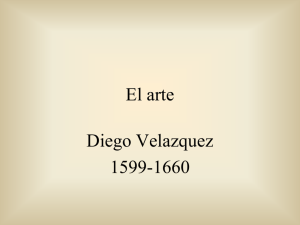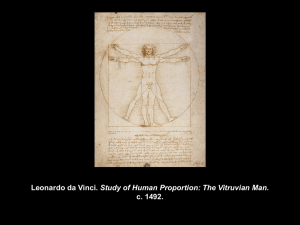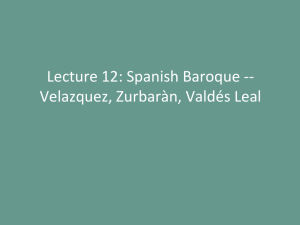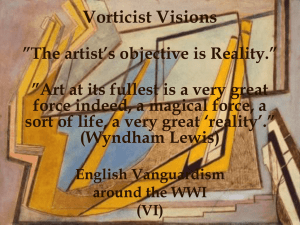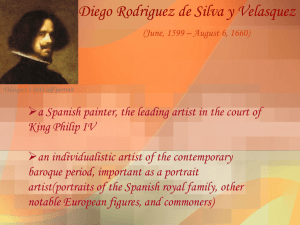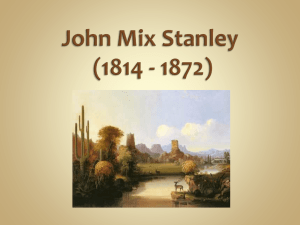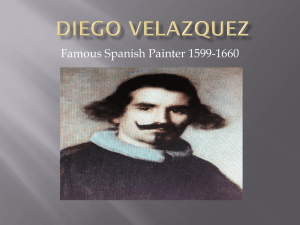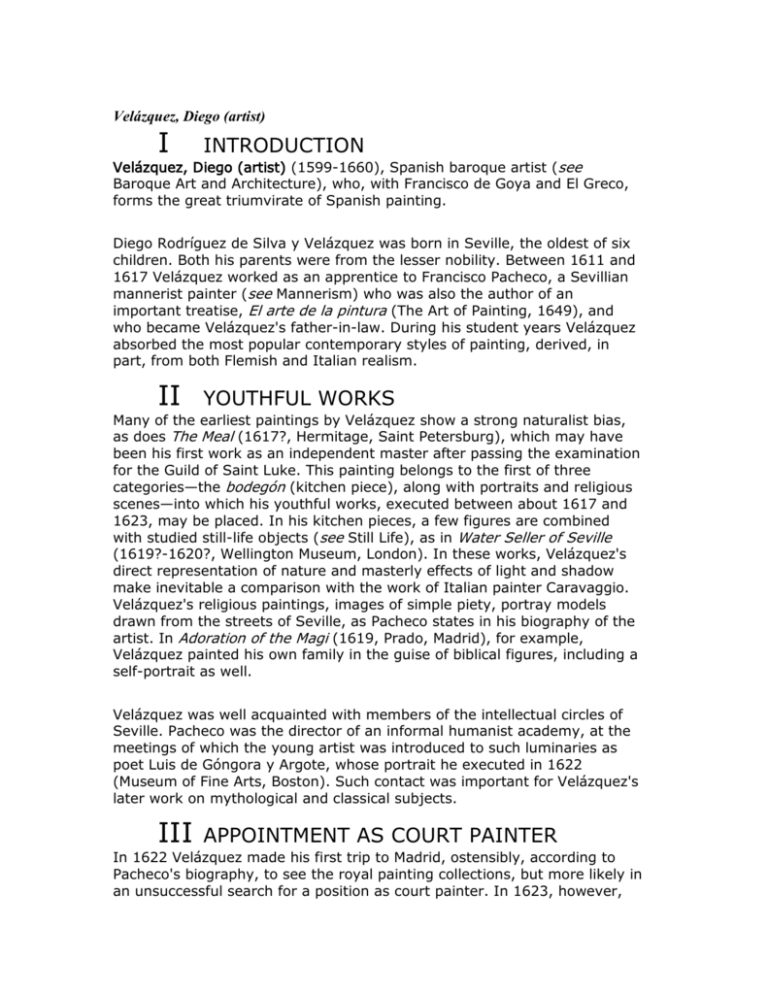
Velázquez, Diego (artist)
I
INTRODUCTION
Velázquez, Diego (artist) (1599-1660), Spanish baroque artist (see
Baroque Art and Architecture), who, with Francisco de Goya and El Greco,
forms the great triumvirate of Spanish painting.
Diego Rodríguez de Silva y Velázquez was born in Seville, the oldest of six
children. Both his parents were from the lesser nobility. Between 1611 and
1617 Velázquez worked as an apprentice to Francisco Pacheco, a Sevillian
mannerist painter (see Mannerism) who was also the author of an
important treatise, El arte de la pintura (The Art of Painting, 1649), and
who became Velázquez's father-in-law. During his student years Velázquez
absorbed the most popular contemporary styles of painting, derived, in
part, from both Flemish and Italian realism.
II
YOUTHFUL WORKS
Many of the earliest paintings by Velázquez show a strong naturalist bias,
as does The Meal (1617?, Hermitage, Saint Petersburg), which may have
been his first work as an independent master after passing the examination
for the Guild of Saint Luke. This painting belongs to the first of three
categories—the bodegón (kitchen piece), along with portraits and religious
scenes—into which his youthful works, executed between about 1617 and
1623, may be placed. In his kitchen pieces, a few figures are combined
with studied still-life objects (see Still Life), as in Water Seller of Seville
(1619?-1620?, Wellington Museum, London). In these works, Velázquez's
direct representation of nature and masterly effects of light and shadow
make inevitable a comparison with the work of Italian painter Caravaggio.
Velázquez's religious paintings, images of simple piety, portray models
drawn from the streets of Seville, as Pacheco states in his biography of the
artist. In Adoration of the Magi (1619, Prado, Madrid), for example,
Velázquez painted his own family in the guise of biblical figures, including a
self-portrait as well.
Velázquez was well acquainted with members of the intellectual circles of
Seville. Pacheco was the director of an informal humanist academy, at the
meetings of which the young artist was introduced to such luminaries as
poet Luis de Góngora y Argote, whose portrait he executed in 1622
(Museum of Fine Arts, Boston). Such contact was important for Velázquez's
later work on mythological and classical subjects.
III
APPOINTMENT AS COURT PAINTER
In 1622 Velázquez made his first trip to Madrid, ostensibly, according to
Pacheco's biography, to see the royal painting collections, but more likely in
an unsuccessful search for a position as court painter. In 1623, however,
he returned to the capital and, after executing a portrait (1623, Prado) of
the king, was named official painter to Philip IV. The portrait was the first
among many such sober, direct renditions of the king, the royal family, and
members of the court. Indeed, throughout the later 1620s, most of
Velázquez's efforts were dedicated to portraiture. Mythological subjects
would at times occupy his attention, as in Bacchus, also called The Drinkers
(1628-1629, Prado). This scene of revelry in an open field, picturing the
god of wine drinking with a group of tough-looking men, testifies to the
artist's continued interest in realism.
IV
TRIP TO ITALY
In 1628 Flemish master Peter Paul Rubens came to the court at Madrid on a
diplomatic mission, and Velázquez was one of the few painters with whom
he associated. Although Rubens did not have a direct impact on the style of
the younger painter, their conversations almost certainly inspired Velázquez
to visit the art collections in Italy that were so much admired by his fellow
artist. In August 1629 Velázquez departed from Barcelona for Genoa and
spent most of the next two years traveling in Italy. From Genoa he
proceeded to Milan, Venice, Florence, and Rome, returning to Spain from
Naples in January 1631. In the course of his journey he closely studied both
the art of the Renaissance and contemporary painting. Several of the works
he executed during his travels attest to his assimilation of these styles. A
notable example is Joseph and His Brothers (1630, El Escorial, near
Madrid), which combines a Michelangelesque sculptural quality (see
Michelangelo) with the chiaroscuro (light-and-shadow techniques) of such
Italian masters as Guercino and Giovanni Lanfranco.
V
RETURN TO SPAIN
On his return to Madrid, Velázquez resumed his duties as court portraitist
with the rendition Prince Baltasar Carlos with a Dwarf (1631, Museum of
Fine Arts), an image made poignant by the young prince's death before
reaching adulthood. In 1634 Velázquez oversaw the decoration of the
throne room in the new royal palace of Buen Retiro. His scheme was based
on 12 scenes of battles in which Spanish troops had been victorious—
painted by the most prestigious artists of the day, including Velázquez
himself—and royal equestrian portraits. Velázquez's contribution to the
cycle of battle pictures included the Surrender of Breda (1634, Prado),
which portrays a magnanimous Spanish general receiving the leader of
defeated Flemish troops after the siege of the town of Breda in 1624. The
delicacy of its style and the astonishing range of emotions it captures make
this the most celebrated historical composition of the Spanish baroque.
Velázquez's second major series of paintings from the 1630s is a group of
hunting portraits of the royal family for the Torre de la Parada, a hunting
lodge near Madrid. His famous depictions of court dwarfs, in which, unlike
court-jester portraits by earlier artists, the subjects are treated with respect
and sympathy, date from the late 1630s and early 1640s. Velázquez
painted few religious pictures after entering the king's employ; Saints
Anthony and Paul (late 1630s, Prado) and Immaculate Conception (1644?,
Prado) are notable exceptions.
VI
LATE WORKS
During the last 20 years of Velázquez's life, as his rise to prominence in
court circles continued, his work as court official and architect assumed
prime importance, limiting his artistic output. In 1649 he made a second
trip to Italy, this time to buy works of art for the king's collection. During
his year's stay in Rome from 1649 to 1650 he painted the magnificent
portraits Juan de Pareja (Metropolitan Museum of Art, New York City) and
Pope Innocent X (Palazzo Doria-Pamphili, Rome). At this time he was also
admitted into Rome's Academy of Saint Luke. The so-called Rokeby Venus
(National Gallery, London) probably dates from this period as well.
The key works of the painter's last two decades are Las Hilanderas (The
Spinners, 1657?-1658?, Prado), also known as The Fable of Arachne (see
Arachne), an image of sophisticated mythological symbolism, and his
masterwork, Las meninas (The Maids of Honor, 1656, Prado), a stunning
group portrait of the royal family and Velázquez himself in the act of
painting.
Contributed By:
Edward J. Sullivan
1
1"Velázquez, Diego (artist)."Microsoft® Encarta® Encyclopedia 2001. © 1993-2000
Microsoft Corporation. All rights reserved.

